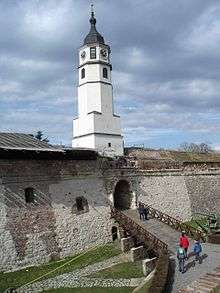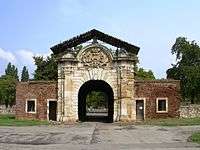Gates of Belgrade
This article describes 23 gates of Belgrade.
Roman gates
Remains of southeastern gate of the Singidunum's castrum were found when adapting the building of the Belgrade Library, with one of its towers now being in the library depot and the other across the street in the small park with Milan Rakić's bust. The gate was located exactly at the end of Knez Mihailova and entrance of Kalemegdan park, at 44°49′12″N 20°27′12″E. Thus this entrance stayed at the same place for nearly 2,000 years.[1]
Northwestern gate of the castrum was located roughly at the same place as today's Defterdar's Gate.[2]
Fortress gates
Upper city gates
These are gates in the walls of the Upper City of the Belgrade Fortress. Gates that are connected to each other are not exactly aligned. This was done to prevent use of siege engines on the inner gate, if the outer gate would be breached.
| Name | Photograph | Built | Location | Description |
|---|---|---|---|---|
| Clock Gate |  |
17th century | 44°49′23″N 20°27′2″E | Southeastern gate in the innermost city wall, it is connected via a bridge to the Inner Stambol Gate. The complex on the southeast ramparts actually consists of two gates, connected by the smaller, side room. The original passage was built for the first time in 1688, after the Austrians conquered Belgrade from the Ottomans. After the Ottomans retook the fortress in 1690, they reconstructed this section of the ramparts and expanded the passage. After the Austrians again conquered Belgrade, from 1717 to 1739, a massive Baroque reconstruction of both the fortress and the city began. A new, Baroque Gate, was dug through, but after another takeover by Ottomans, this gate was walled after 1740 and the Clock Gate became operational again. This is when the clock tower above it was built, which gave the gate its name.[3] It was built by the Venetian architect Andrea Cornaro, and also sometimes called Cornaro's Gate.
The Baroque Gate was revitalized in 1987 and the gallery of the Belgrade Fortress moved in. Restoration works were held in 2003, when it became obvious that a much serious reconstruction is needed. A temporary, protective wooden eave was built above the entrance of the Clock Gate. The Baroque Gate deteriorated a lot, so it was closed for the visitors. In December 2019, a complete renovation of both gates was announced. All parts of the various reconstructions and adaptations are clearly visible on the gates. [3] |
| Defterdar's Gate |  |
44°49′26″N 20°26′56″E | Northwestern gate in the innermost city wall, accessible only via a steep stairway. Entrance complex at the gate is partially preserved. | |
| Despot's Gate |  |
1404-1427 | 44°49′30″N 20°27′2″E | Northeastern gate in the innermost city wall, located right next to the Despot's Tower. It is connected via a bridge to the Zindan Gate. The gate is named after despot Stefan Lazarević. The gate and tower are the best preserved medieval part of the fortress. |
| Inner Stambol Gate |  |
around 1750 | 44°49′21″N 20°27′3″E | The main gate of the fortress. Southeastern gate in the second city wall, connected via a bridge to the Clock Gate, and via a land bridge to the outer ravelin, where the way forks towards Karadjordje's and Outer Stambol Gate. The gate is named after Istanbul. |
| Karađorđe's Gate |  |
18th century | 44°49′18″N 20°27′3″E | Southern gate of its ravelin, built in the early 18th century. In the 19th century it was named after Karađorđe, cause it was erroneously thought that he passed through this gate during the liberation of Belgrade from the Ottomans in 1806. Karađorđe, however, entered via the main road and outer Stambol Gate. For the most part, the gate was walled, already in the late 18th century, and then again after 1813, only to be re-opened after World War II. It is accessible over the small bridge which is being regularly restored (1987, 2005, 2020).[4] |
| King Gate |  |
around 1725 | 44°49′22″N 20°26′52″E | Southwestern gate in the innermost city wall. The gate is descended to via a short stairway which passes next to the Roman Well. A bridge then connects it with the King Ravelin. |
| Leopold's Gate |  |
around 1690 | 44°49′30″N 20°27′6″E | The outermost northeastern gate, connected via a bridge to the Zindan Gate. It was named after Leopold I. |
| Outer Stambol Gate |  |
1840-1860 | 44°49′20″N 20°27′7″E | Eastern gate of its ravelin, it is named after Istanbul. |
| Southern Gate | Built in the 15th century, also called the Baroque Gate;[5] it existed right next to the Clock Gate and was built shut when the later was opened. Today it is turned into a museum. | |||
| Zindan Gate | mid-15th century | 44°49′33″N 20°27′5″E | The middle southeastern gate, between two round towers. Since the 18th century, the Ottomans used towers' basement as dungeon, a zindan, hence the name of the gate.[6] It is connected with bridges to the Despot's Gate on the inside and Leopold's Gate on the outside.
The wooden bridge in front of the gate was reconstructed in 2005 and 2020.[7] |
Lower city gates
| Name | Photograph | Built | Location | Description |
|---|---|---|---|---|
| Dark Gate |  |
44°49′19″N 20°26′49″E | The southern gate of the lower city. The gate and entire complex surrounding it saw extensive renovation in 2007 and 2008. | |
| Gate of Charles VI (Gate of Karl VI) |  |
1736 | 44°49′33″N 20°26′57″E | Built as triumphal arch of Charles VI, it is one of very few baroque buildings in Belgrade.[8] |
| Inner Sava Gate |  |
|||
| Outer Sava Gate |  |
|||
| Port Gate |  |
44°49′39″N 20°26′58″E | Main entrance to Belgrade's port. | |
| Vidin Gate |  |
18th century | 44°49′37″N 20°27′6″E | Northeastern gate of the Lower City. |
| Water Gate I | 44°49′28″N 20°26′45″E | |||
| Water Gate II | 44°49′36″N 20°26′49″E |
Outer city gates
When Austrians occupied northern Serbia, including Belgrade, in the early 18the century, apart from rebuilding and renovating the Fortress, they dug a moat outside of the Fortress, as the first line of defense. It became known as the "Laudan trench" (Serbian Laudanov šanac or simply Šanac). It was up to 6 meters wide, 2 meters deep and on the outer side had reinforcements in the form of earth embankments or walls. In order to get to and out of the city, a system of many gates and bridges was built through and on the trench. They all had a permanent military crew and were always locked at night.[9] These outer city gates were demolished from 1862 to 1866,[10] together with the outer city wall they were in. Commemorative plaques mark their former locations now.
| Name | Photograph | Built | Location | Description |
|---|---|---|---|---|
| Sava Gate |  |
44°49′6″N 20°26′58″E | The Southern city gate. It was through this gate that revolutionaries entered Belgrade to capture it during the Siege of Belgrade (1806), in the First Serbian Uprising, after it was opened by Uzun-Mirko and Konda Bimbaša.
It was connecting Savamala, the former village, and later the first Belgrade neighborhood outside of the fortress built from 1834, with the fortress. The gate was demolished in 1862.[10] | |
| Stambol Gate |  |
1723-1739[11] | 44°48′59″N 20°27′37″E | The southeastern and main city gate, it was located in front of today's National Theatre. It was built by Austria.[11] Later, the gate was used for public executions. A symbol of Turkish oppression,[11] it was demolished in April–May 1866.[11] |
| Varoš Gate |  |
44°48′59.5728″N 20°27′11.1276″E | The gate was in the wall between Stambol and Sava gates. It was located where Pop Lukina today receives Maršala Birjuzova street. Remains of the gate can still be found as part of the foundations of the neighboring houses. Varoš Gate (in Serbian Varoš Kapija) gave its name to the surrounding neighborhood.[9] It was demolished in 1862.[10] | |
| Vidin Gate |  |
44°49′14″N 20°27′55″E | The eastern city gate, located near today's First Belgrade Gymnasium. A road which started at the gate was called Vidin Road (Vidinski drum). Section of the road between the Tadeuša Koščuška and the "Bajloni market" was later renamed Cara Dušana, while the remaining section, to the Takovska, is today named Džordža Vašingtona.
The gate was demolished in 1862.[10] |
Modern gates
| Name | Photograph | Built | Location | Description |
|---|---|---|---|---|
| Eastern Gate of Belgrade |  |
1980 | 44°47′3″N 20°30′44″E | A complex of three highrise residential buildings easily visible on approach to Belgrade from east on the E75 highway. |
| Western Gate of Belgrade |  |
1977 | 44°49′13″N 20°24′17″E | A highrise, easily visible on approach to Belgrade from west on the E70/E75 highway. While the building looks like a gate, having two towers connected at the top, the highway actually passes southwest of the building. |
References
- Beograd-Singidunum, treći deo
- Beograd-Singidunum, četvrti deo
- Branka Vasiljević (27 December 2019). Најзад обнова Сахат и Барокне капије [Finally a reconstruction of the Clock and Baroque gates]. Politika (in Serbian). p. 15.
- Ana Vuković (4 February 2020). Обнавља се мост код Карађорђеве капије [Bridge at Karađorđe's Gate renovated]. Politika (in Serbian). p. 14.
- Daliborka Mućibabić (23 March 2011), "Trka s vremenom za spas Južne kapije", Politika (in Serbian)
- Branka Vasiljević (19 February 2020). Обнова мостова на Београдској тврђави [Restoration of the bridges in Belgrade Fortress]. Politika (in Serbian). p. 15.
- Daliborka Mučibabić (14 April 2020). Обновљен мост код Зиндан капије [Bridge at Zindan Gate was reconstructed]. Politika (in Serbian). p. 14.
- Popović, Marko (November 2012). "Капија цара Карла VI у Београду" (PDF). Nasleđe. Belgrade: Institute for Protection of the Cultural Monuments of Belgrade (XIII): 9. Retrieved 2013-12-15.
- Dragan Perić (23 April 2017), "Šetnja pijacama i parkovima", Politika-Magazin No 1021 (in Serbian), pp. 28–29
- Goran Vesić (3 January 2019). Београдска тврђава [Belgrade Fortress]. Politika (in Serbian). p. 16.
- Rajković, Ljubinka (1973). "Још једанпут око два споменика из старог Београда" (PDF). Annual of the City of Belgrade. Belgrade: Belgrade City Museum (XX): 229. Retrieved 2013-12-06.
External links
| Wikimedia Commons has media related to Gates of Belgrade. |